Danielle Choi
Jorge Otero-Pailos
Experimental preservationists share a common interest in using existing historic objects, buildings, landscapes to think differently about the future. That is quite different from traditional historic preservation, where the object of heritage is understood as stable. Experimental preservationists look carefully at how heritage objects are constructed in the present and then find new purposes for them.
DC
In your 2016 book Experimental Preservation, you convene discussions around artistic and architectural work that ranges from discourse to unbuilt proposals to realized urban interventions. All of the work presented offers a critique of traditional preservation, but it is also a new form of cultural production. There seems to be deep optimism and joy in this kind of making.
JOP
Absolutely—there is a new sense of the capacity of preservationists to impact the world. Preservationists work with a mode of creativity that is not about form-giving, but about form-taking and guiding attention.
The kinds of objects that they propose can’t be singular and subjective creations. They are what I would call, borrowing from pediatrician and psychoanalyst Donald Winnicott, “not-me creations,” which are objects created collectively through interactions among specific people or interests.
The process of preservation engages in social dialogue about objects: What is real and what is not? How do we understand our environment? What do we care about? In experimental preservation, practitioners are willing to unpack these protocols. This practice is not necessarily associated with the purpose of traditional preservation, which is to uphold national identities—in other words, to serve the state directly or indirectly.
You’re seeing many more contentious types of preservation projects that question the authority or structures of governmentality. The work suggests the different ways in which we gather as communities. After all, these monuments, historic sites, landscapes—they are for all of us. Philosopher Michel Serres talks about soccer balls in this way: if you don’t have a ball, you don’t have a game. Experimental preservationists work with objects to see what kinds of games—serious games—can be played to describe how we interact as a society.
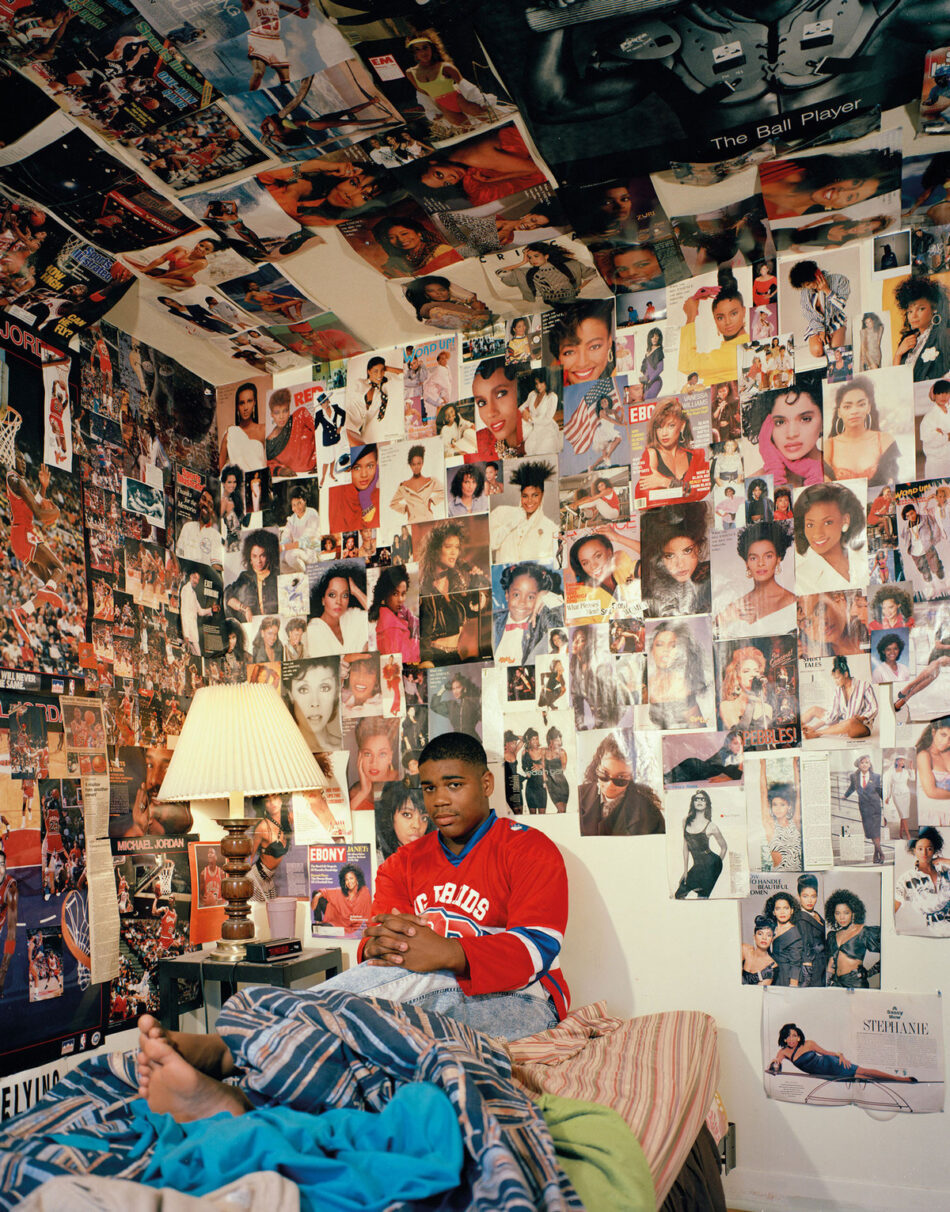
DC
JOP
A not-me creation is always created collectively. It suggests that we might interact through objects and ask one another questions like, “Do you like this monument, or not?” We might learn from one another in the process. That sounds very abstract, but let me give an example from psychoanalysis and Winnicott’s work with children. Children use not-me creations. The teddy bear or the blankie are ways to deal with the anxiety of not knowing the future. Children have a difficult time telling the difference between dreams and reality. When they go to sleep, they don’t know if they’ll wake up again or if their parents will be there. The way the child deals with this is to choose an object, usually a soft object, and to act as if that object is vitally important. They behave toward that object in a very strange way, right?
If you follow Winnicott’s thinking, what they’re trying to do is ask their parents a question that they cannot articulate: Is this object real? If the parents behave toward this object as if it’s real and vitally important to the child, then the child will find comfort in that object. For example, if a child leaves the teddy bear at a friend’s house, and the child starts throwing a tantrum, you turn around and get the bear. That’s your way of answering the child’s question. We use objects throughout our lives to ask one another questions about reality. In teenagehood, we latch on to different objects. We might suddenly dress in a different way, form attachments to certain music, acting as if that is who we are.
When we choose an object, we’re actually trying to engage society. That’s what the very radical proposition of experimental preservation is: we deploy objects as a way to raise fundamental questions about what’s important to us.
DC
The kinds of objects we use to probe reality as children are intimate vessels of communication with our parents. As teenagers, we use objects to broadcast our affiliations and alliances in the world. Can you elaborate on this distinction?
JOP
Fundamentally, the world is run by middle-aged people. Because they’re in power, those people create a world that other middle-aged people might be interested in.
Teenagehood is embarrassing to most people. As a teenager, you’re negotiating a material world that rejects the previous one you inhabited—the world of your parents or caregivers. You begin to choose objects that are recognizable to your peers and yet still function in the previous world. Your parents have an opinion about these objects—hopefully, a negative opinion, right? That piercing, for example, or that skirt that’s just not acceptable. Objects are very powerful in helping us transition in life.
DC
Discussing teenage expression makes me think of 5Pointz in Long Island City, Queens, which was a prominent site for graffiti for many years. It was a highly visible example of graffiti artists claiming a kind of right to the city, but when the building was finally up for redevelopment, advocates for the arts (unsuccessfully) appealed to traditional modes of preservation. In a more rarefied example, you’ve noted Gordon Matta-Clark as a pioneer of experimental preservation. These two examples are related in the sense of inventing a public realm through some form of creative destruction. What is the role of creative destruction in the practice of experimental preservation?
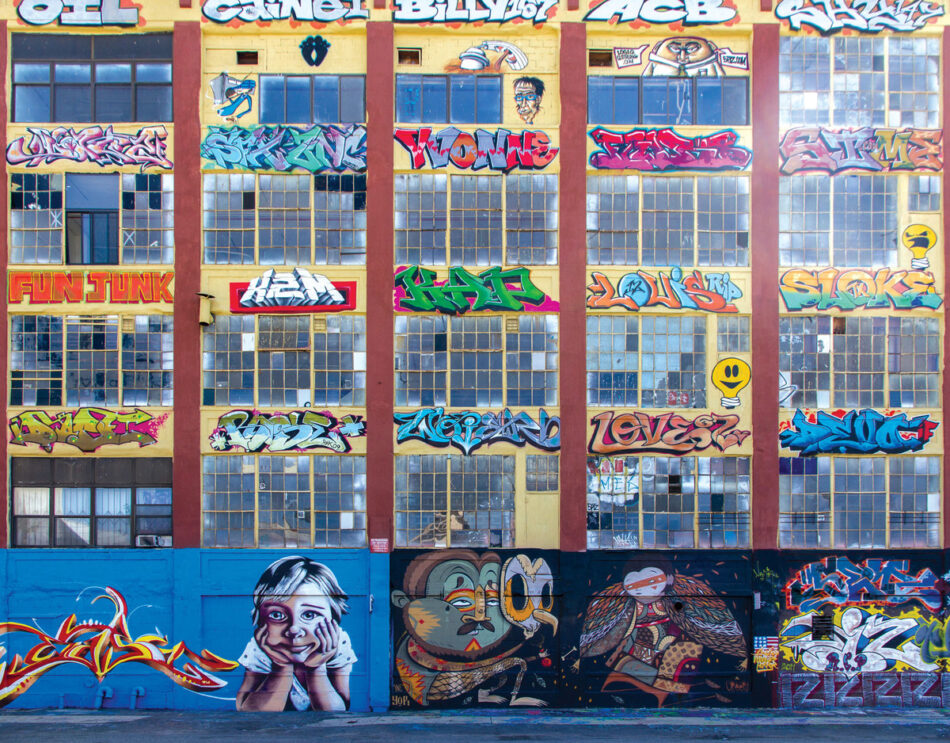
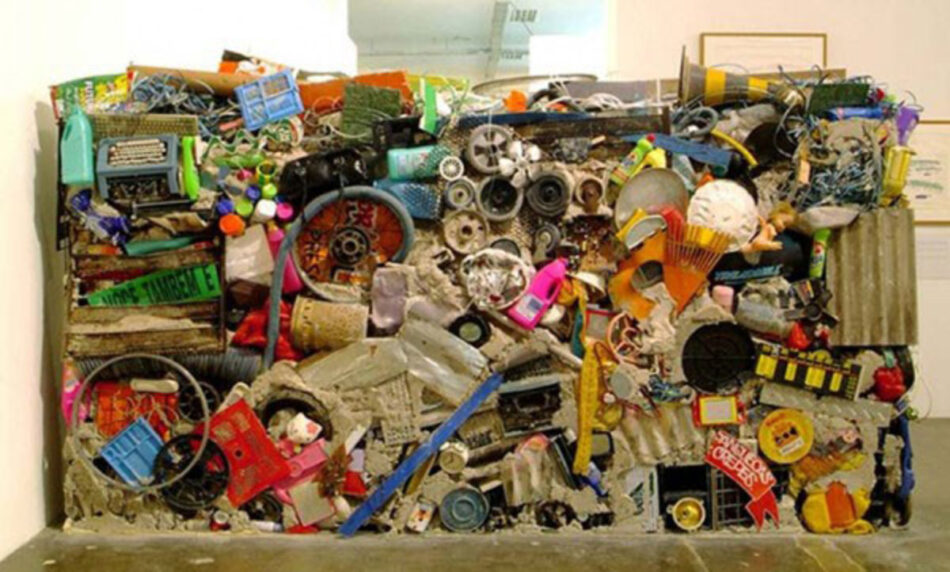
JOP
This question goes to the heart of the way in which we behave toward objects. What do not-me creations really do? They serve us through transitions by providing experiential continuity. They must smell the same, feel the same, and look the same before and after the transition. In other words, we transition, we change, but they don’t.
For example, it’s important that you never wash the teddy bear, because then the child will not recognize its particular smell. The object has to provide experiential continuity. As a teenager, you might be wearing the same jacket for three, four years. As part of this process, we mistreat the object tremendously. As we insist on its endurance as a vessel for experiential continuity, we deny that object a certain kind of care, such as mending or cleaning. You’re actually destroying the object and allowing it to enter into an expedited decay. Preservation is certainly not the more forgiving way that we behave toward other objects. What is left after all that punishment, all those attempts to destroy it? It’s what we think of as the object itself.
There is a powerful critique of preservation to be unpacked within the notion of fetishism, because heritage should help us transition from one stage of culture into another. But when we hang on to an object beyond what should be a transitional period, then we are still stuck, and we become fetishistic toward that object.
The notion of destruction is really important, but it doesn’t mean that objects should be destroyed. It means that as we care for objects in a particular way, we are actually destroying them. At a certain point, we can accept the object for what it is and let go. That’s how we let go of our teenage world. We say, “Yeah, well. Those were my teenage years.”
As I’m talking to you, I’m looking out the window, and there is a student walking by with a T-shirt with the number 17 on it.
DC
Really? Amazing! . . . On this idea of transition and destruction—the 2016 issue of the conservation journal Change Over Time, devoted to landscape preservation and climate change, implicitly presents the essence of a place as defined at a single moment in time by an original author. Once this idea of experiential continuity is seriously threatened, we feel a sense of loss and begin to think of landscapes as if they were discrete objects.
One of the paradoxes of landscape preservation is that some of these materials and phenomena—moisture, soil, microbes, vegetation, wind—are the constituent elements of dynamic forms in the landscape, but they are also forces of degradation and change.
Your ongoing installation-based project The Ethics of Dust touches upon related environmental phenomena: How do you maintain integrity over time? How far can an act of experimental preservation stray from the original artifact? How much autonomy does the not-me creation have?
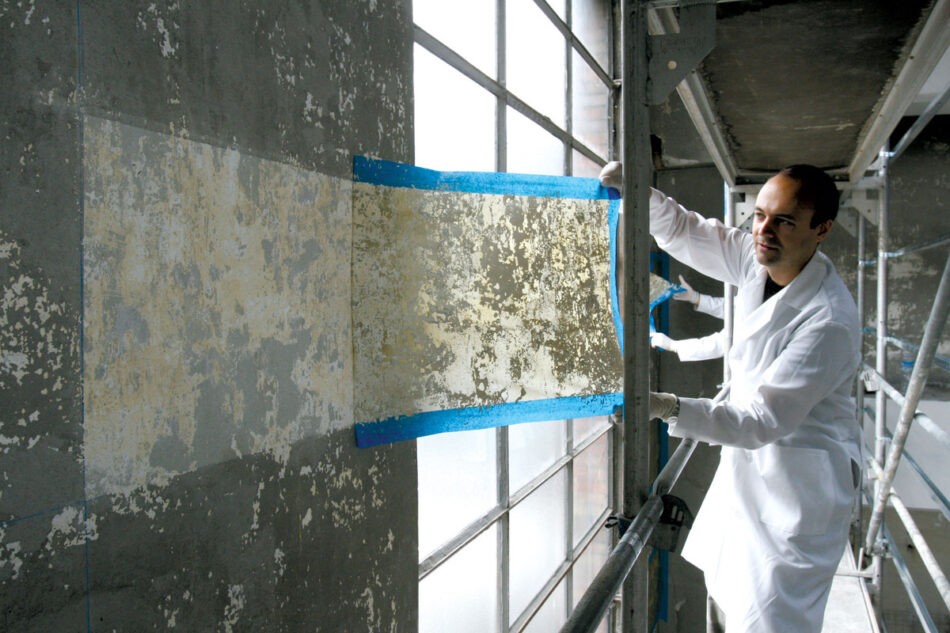
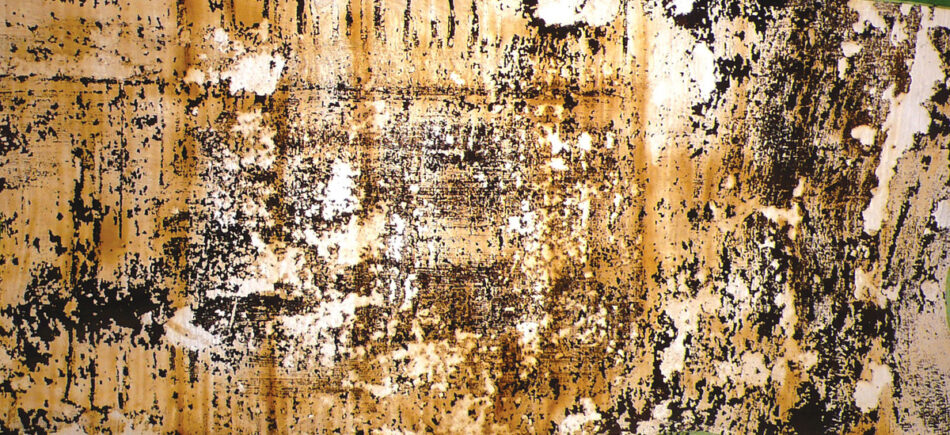
JOP
The Ethics of Dust casts are made in the act of cleaning monuments. The dust that is sitting on the surface of monuments is transferred onto a sheet of conservation latex, which then becomes an independent object for consideration. For a lot of people, the dust is extrinsic to the architecture because it is deposited from the atmosphere. For me, the dust belongs to the building.
Dust registers the history of the building. I’m trying to call into question the notion that architecture can be distinctly separated from the atmosphere, because you cannot have all these buildings without producing pollution. The coal and petrol consumed in order to make building materials, to produce energy used to assemble these materials, and to heat buildings—all that Marx would call a “constitutive externality”—that’s all up in the sky.
What we call the weather wasn’t really invented until the mid- to late 19th century. Preservationists like the chemist Robert Angus Smith, member of the Society of Antiquaries of Scotland, discovered that the mortar of buildings was decaying too fast in Manchester. He investigated the causes, realized that there was sulfuric acid in the rainwater, and called it “acid rain.” That’s when we began to talk about chemical climatology. So, at the very time that people were trying to figure out weather patterns, we were also beginning to understand that the weather is human-made.
Buildings are the best sensors that we have for long-term environmental change. The Ethics of Dust is a call to the discipline to look at buildings as millennial sensors, centennial sensors. Each work is very particular; each one is a different attempt at understanding, at rendering the atmosphere intelligible in its historical depth. I want to expose the atmosphere as something sedimented over time onto buildings.
DC
Data collection as an experimental preservationist practice opens a lot of potential in landscape. The spread of the emerald ash borer throughout the American Midwest, or the fate of the American chestnut tree—these are tragedies that we think of as happening to constructed landscapes, rather than related to intertwined forces of urbanization and commerce. We need to understand and demonstrate this information in a way that is not merely reactionary, but can be generative, or even poetic.
JOP
There was a lot of collaboration between arborists and preservationists in the 19th century. As Robert Angus Smith was looking at mortar, others were looking at the loss of vitality in plants under extremely polluted conditions. Landscape brings an understanding of life’s relationship to the atmosphere that is core to our current moment of transition. We’re being presented with this image that the future has leaped over the present. But we are actually engaged in a past-determined future, and we don’t have the options to imagine it in a frictionless way.
We don’t know what kind of object would help make our transition constructive and edifying, rather than eliciting a sense of loss. Today, we know a very different reality than at the beginning of industrialization, where modernity could shape the future through technological innovation. But for the most part, our societies still believe that all we have to do is invest more in technology.
DC
There’s a sense that we can turn the ship around, but we don’t have to make deep structural changes to the map or the territory.
JOP
We have to be very careful with the types of illusions and delusions that we involve ourselves in. We don’t have the institutional capacity to manage the environment at the scale of what we’re facing.
We’re disassembling the reach of many institutions, and at the same time, talking about managing the seas, the atmosphere, all species’ survival. We have managed life by reducing it to the least common denominator of survival: chicken, beef, and pork, out of all animals; lettuce, tomato, and cucumber, out of all vegetables.
The not-me creation begins with an illusion of omnipotence. When the child is hungry and gets fed, it feels omnipotent. When we pick up a salad at restaurant, we have that sense of omnipotence. We don’t depend on the world; we create it with our money. Our ability to manage the world is based on an underlying sense of delusional omnipotence. The not-me creation gently frustrates that delusion.
In teenage years, you’re sort of immortal, and at the same time, you’re weak and can’t participate in democratic life by voting. You can’t legally drink, but you can get wasted and function the next day. You’re helped along the way by certain objects that frustrate the illusion of omnipotence, and by your 20s, you realize that you’re mortal and that there are some constraints in reality.
Preservation is a way of choosing not-me creations, putting them forth as potential objects of transition, and seeing whether they serve a purpose. It might be for a day. It might be for 50 years. It might be for 17 years.
Jorge Otero-Pailos works at the intersection of art, architecture, and preservation. He is director and professor of historic preservation at Columbia University. His work has been commissioned and exhibited by major museums, foundations, and biennials, notably, the Artangel Trust, the 53rd Venice Art Biennale, the Victoria and Albert Museum, Louis Vuitton Museum’s La Galerie, Thyssen-Bornemisza Art Contemporary, and the Yerba Buena Center for the Arts. He is author of Architecture’s Historical Turn: Phenomenology and the Rise of the Postmodern (2010), founder and editor of the journal Future Anterior, and coeditor of Experimental Preservation (2016).
Danielle Choi is assistant professor of landscape architecture at the Harvard University Graduate School of Design. Her current research concerns civil waterworks and the public realm and the politics of landscape preservation in living environments.